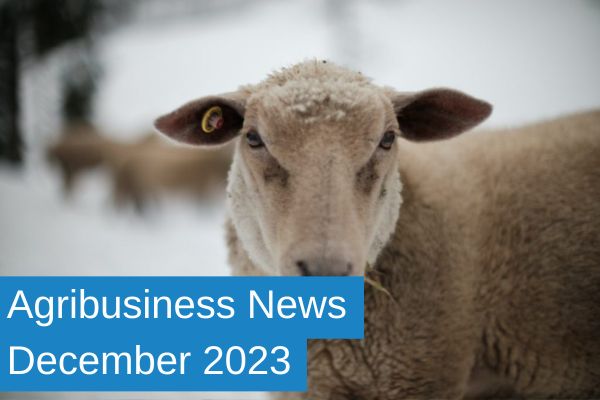Agribusiness News December 2023 – Input Costs: Ewe Management
30 November 2023Be conditioned about Conditioning
Ewe Condition in Mid-Pregnancy
Body condition scoring (BCS) is an essential tool for assessing the nutritional status of ewes. During mid-pregnancy, ideally, the BCS should be maintained around BCS 3-3.5 (2-2.5 for hill ewes), ensuring the health of both the ewe and her developing foetus. There is a wealth of research which shows how ewes under target BCS are more likely to die and, how the BCS targets relate to greater rearing rates.
The ewe’s body condition directly influences the quality and quantity of colostrum and milk produced. Sufficient fat reserves are imperative for meeting the increased energy demands of late pregnancy and lactation. The colostrum, vital for lamb immunity and growth, can be adversely affected in quality if the ewe is in poor condition.
The guidance before pregnancy is to get as many to target as possible to reduce the need to ‘correct’ condition score through pregnancy. However, there are years with bad weather and conditions where condition loss through the winter occurs therefore some may be considering options for lean ewes now.
The first key tip is monitoring
Get a feel of the ewes as regularly as possible and split those that are under target for priority feeding. This will effort certainly pay dividends come lambing time.
As a minimum, gauge condition at scanning time and split off the lean ewes to be fed with the triplets or keep them separate altogether, if practical.
Feeding to increase the condition becomes more challenging as pregnancy progresses. Therefore, working to improve it should be done sooner rather than later.
The last six weeks of pregnancy should be the absolute last resort as, at this time, thin ewes tend to give the nutrients to the growing foetus and are more likely to require assistance with lambing.
Energy-dense feeds are needed
Rumen-friendly rations are based on forage, find that with the greatest energy density for these thin ewes. This should be attractive to them to eat, and they should have plenty of access (over 15cm per ewe).
Although ewes like to eat hay, it often has a lower energy density, so a high-energy silage is preferred. With plenty of access, combined with checks that they are consuming the stuff, a silage of 10.5 megajoules of metabolisable energy per kg dry matter (MJ ME/kg DM) will meet the requirements of a 75kg twin-bearing ewe with extra for condition gain up to 7 weeks pre-lambing.
Keep monitoring and, only provide additional hard feed if required. Nutrition from forage is more rumen-friendly than from concentrate feed.
However, in the last six to seven weeks of pregnancy, additional concentrate feeding is often required, but again, the ration should start with energy-dense forage and the protein and energy deficit is met with concentrate feeds.
We cannot undervalue the role of independent nutritionist advice at this stage to calculate more precisely the supplemental feed requirement.
The nutritionist might save you money or might cause you to spend more money, but the feed will be calculated to meet the needs of your flock to give your lambs and ewes a greater chance of survival.
Beware, when buying in forage, you may bring in disease
There have been reports of people bringing toxoplasmosis onto the farm with purchased forage. This disease is associated with cats and the oocysts from toxoplasmosis can survive on grain and conserved forage.
If this reaches naive ewes in early to mid-pregnancy, the foetus often dies or is born with brain damage, later in pregnancy the foetus has a greater chance of surviving but may be born weak.
Once an outbreak of toxoplasmosis has started, there is little that can be done other than to observe sensible precautions by disposing of dead lambs and infected placentas and disinfecting contaminated pens.
Vaccination is warranted in most flocks, but pregnant ewes cannot be vaccinated and there have been supply issues in recent years, therefore discuss with your vet.
Medicated feed with decoquinate (Deccox) is only an option to those 14 weeks away from lambing as this is the duration it needs to be fed to be effective.
Poppy.frater@sac.co.uk
Sign up to the FAS newsletter
Receive updates on news, events and publications from Scotland’s Farm Advisory Service

